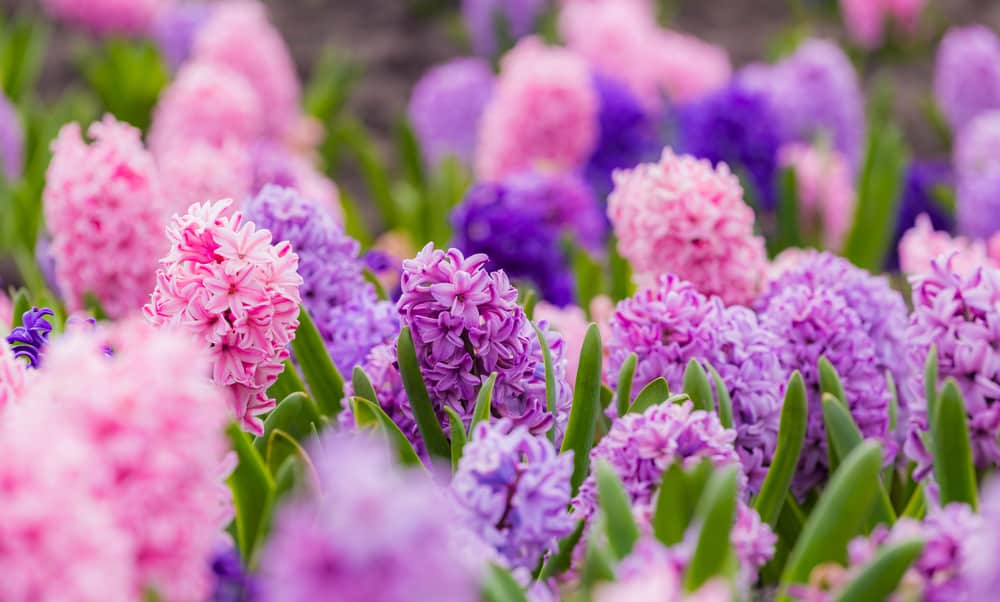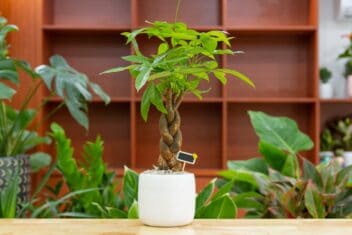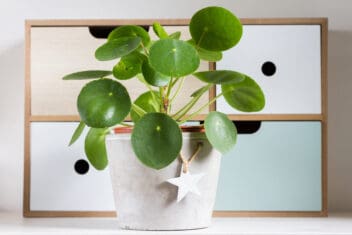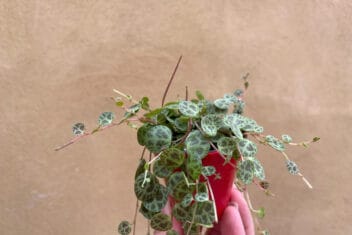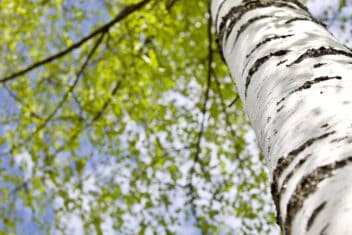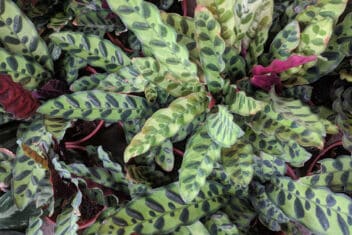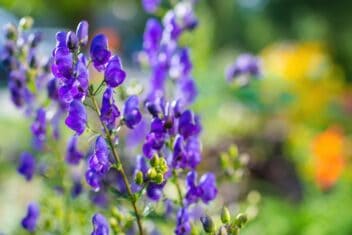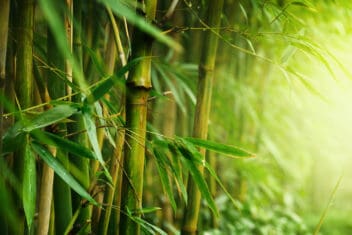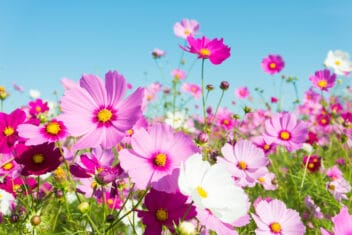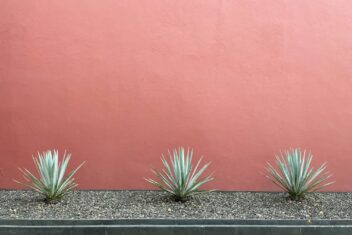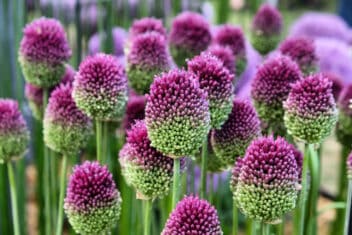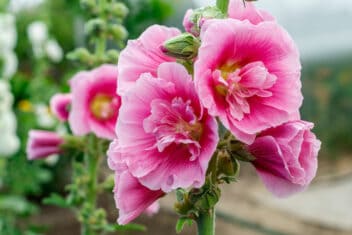Hyacinths are classic flowering plants that many people recognize from their parents’ gardens or colorful Easter displays. Symbolizing peace, commitment, and beauty, they’re popular for forcing. Plus, they add a heady fragrance to the garden.
What’s not to love about growing hyacinths?
These spring-blooming perennials of the Hyacinthus genus have their roots firmly in history. They’re extremely adaptable and versatile, growing in pots, borders, beds, inside, outside, and even in water.
Get to Know Hyacinths
Hyacinths are indigenous to the eastern Mediterranean region. They were first identified botanically by Europeans traveling in Turkey in the 1500s, though they were a valuable and regularly traded plant in the Ottoman Empire prior to the arrival of outsiders.
From there, they rapidly grew in popularity in the Western world, and by the 1700s, they were adored and widely propagated. Dutch bulb growers had bred around 2,000 cultivars by the 1800s.
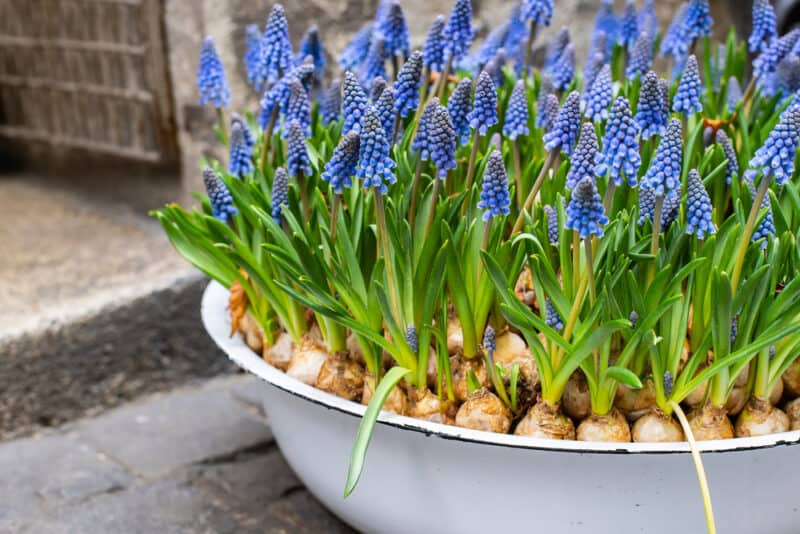
Not to be confused with the grape hyacinth, which is part of the Muscari genus, in the Liliaceae (Lily) family. Nor should you confuse it with the invasive common water hyacinth (Eichhornia crassipes) from the Pontederiaceae (pickerel-weed) family.
Similarly, wild hyacinth (Camassia scilloides) isn’t a true hyacinth, either. It’s also part of the lily family and often goes by the common name camas.
Hyacinths aren’t lilies; they’re part of the Asparagaceae family. Yes, they’re related to asparagus. No, they’re not edible.
There are three species of hyacinth: litwinovii, transcaspicus, and orientalis. If a plant isn’t in one of these species, it isn’t a true hyacinth. It’s the orientalis species that all modern garden hybrids and cultivars come from. We call these Dutch hyacinths.
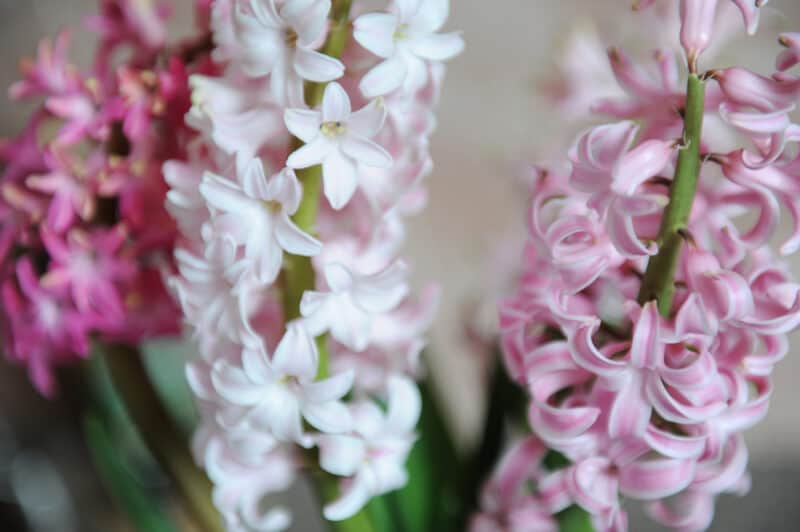
This distinctive plant has close tiers of small star floret flowers, which are categorized as single, double, or multiflora.
Single types have tightly packed, single-blossom florets. Double types have tightly packed, double-blossom florets, meaning they have more petals. Multiflora types are loose and have several flower heads rather than one.
10 Magnificent Types
Here are a few of the best Dutch hyacinths out there. Whether your goal with growing hyacinths is to force some flowers indoors or grow a large bed of blossoms, you’ll find something perfect on this list.
Delft Blue
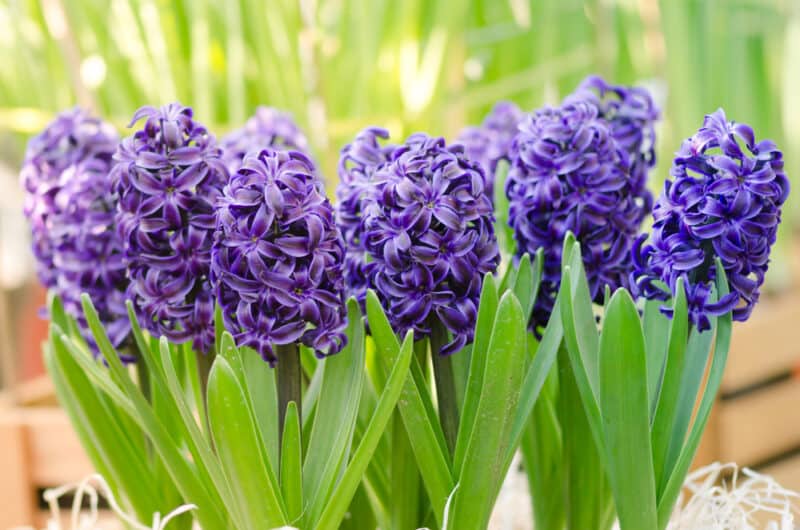
A densely flowered hyacinth with fragrant velvet blue tones and startling green foliage, this beauty has received the Award of Garden Merit from the Royal Horticultural Society.
‘Delft Blue’ grows 8-12 inches in height and four inches wide, making it a great cut flower for mid-spring bouquets and arrangements.
Best planted in groups for maximum effect.
This classic is suitable for pots, borders, beds, window boxes, and containers for those in Zones 4-8. It’s also one of the best choices for early forcing. If you plant it in a garden, it may naturalize over time if left unchecked.
Carnegie
What a show stopper with its flashy white, perfectly tiered, fragrant florets and vibrant green foliage. It’s the perfect beginner option for those new to growing hyacinths.
A long-term bloomer, the flowers last up to three weeks starting in mid-spring. Another perfect exhibit for arrangements and bouquets, ‘Carnegie’ grows between 8-12 inches tall and 3-4 inches wide at maturity and in the right conditions.
As with many hyacinths, it can be planted in all manner of containers, pots, beds, and borders.
Plant at least five bulbs together for a big impact, and then watch the splendor erupt as it blossoms in Zones 4-8. Buy some bulbs at Amazon.
Pink Pearl

In striking contrast to the blues and whites of your typical hyacinth is this pink-powered hybrid. It reminds me of a serving of cotton candy, which is probably why it’s so popular and has won awards worldwide.
Foliage is distinctive green and bold in form, with a neat cluster spread of up to four inches.
Another great one for florists, flower farmers, and displays around the home, ‘Pink Pearl’ fully blooms halfway through spring.
It can naturalize itself in Zones 4-8 or be kept in containers and pots to keep it from spreading.
Anna Liza
Considered a vintage hyacinth, ‘Anna Liza’ upholds the traditional form of hyacinths with its two-tone lavender pink starlet florets aligned like it’s wearing a pinstripe suit.
Great to pot up as a gift for someone or as a cut flower. It can bloom earlier than many other varieties from late winter, if temperatures allow, to late spring.
The blue-green foliage matches its old-world charm and makes this hyacinth stand out from the crowd.
It can grow 10-18 inches in height and spread up to four inches. Numerous bulbs in one spot will make things pop in Zones 4-9.
City of Haarlem
Providing a softer colored option, ‘City of Haarlem’ is a pastel cream to yellow. It’s a lot like the Mister Whippy ice creams of your youth, but without the syrup on top.
An early bloomer by hyacinth standards, it’s covered in late winter in individual florets. It reaches 12 inches by four inches wide at maturity. This hyacinth is a reliable forcer if you are looking for blooming bulbs out of season.
The fragrance packs a marvelous punch. I’m definitely adding this to my list for growing hyacinths.
Jan Bos
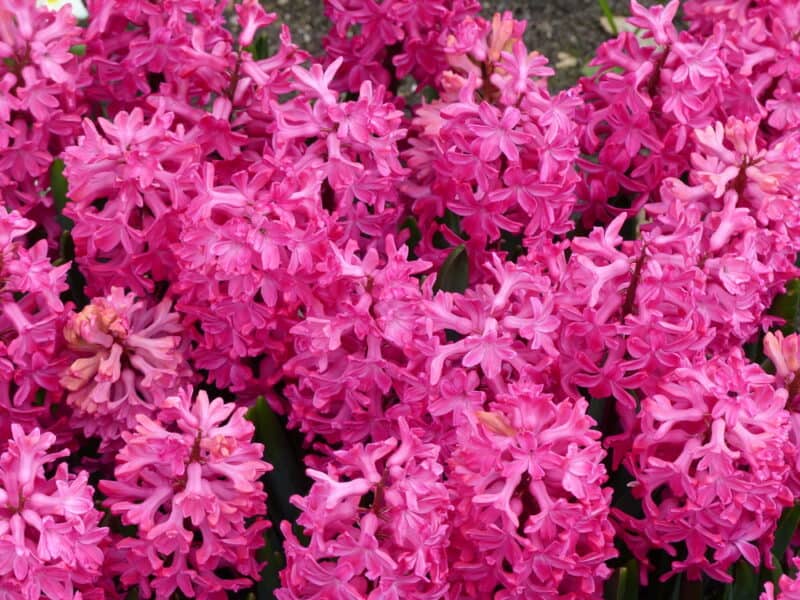
While many Dutch hyacinths change colors as they mature, ‘Jan Bos’ is fade-resistant and remains in-your-face, vibrant reddish-pink.
Blooms mid springtime standing up to 12 inches tall and about four inches wide.
If you collect vibrant blooms, this is a fantastic option, guaranteed to make a statement. In addition to the blooms, the strong green of its foliage will brighten up any landscape in Zones 4-8.
Top White
‘Top White’ features dramatic white blossoms on strong green stems with thick foliage and a more delicate fragrance than some others.
It is slightly shorter and wider than mainstream Dutch hyacinths at 7-11 inches with three to five-inch spread.
It would make an incredible wedding flower, either in pots for table decorations or as a bridal bouquet. It grows well in Zones 3-9.
Miss Saigon
With subtle yet powerful mystic lilac to purple tones, the longer you stare at this remarkable specimen of hyacinth, the more it draws you in.
Described as pure elegance in scent, it’s an all-over winner and a favorite for growing hyacinths.
Grows to a height of approximately 10-12 inches by four inches wide, it’s a marvelous option for cooler regions as its hardy to Zones 2-8.
Gipsy Queen
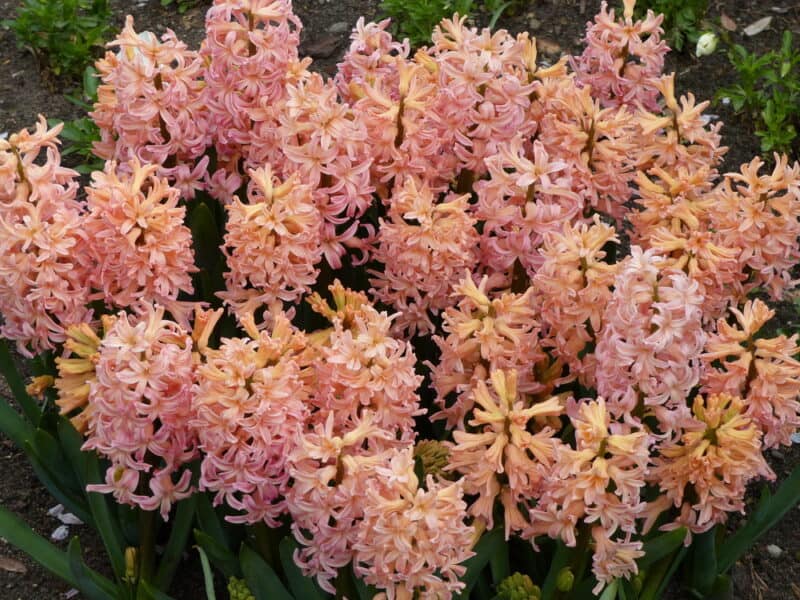
‘Gipsy Queen’ stands out from the crowd in smokey salmon with a hint of gold in the center of each star-shaped floret.
At 10-12 inches tall, it can provide blooms from late winter to mid-spring with the right weather and environment.
Great for pots and containers, it does best in Zones 5-8. Outside of these Zones, pot growing is ideal as they can be moved indoors when winter arrives.
Midnight Mystic
Want dark and mysterious? Then this is the one for you. ‘Midnight Mystic’ kicks the traditional pink, blue, and white hyacinth out of the park with its dark, nearly black blossoms.
Imagine ‘Jan Bos’ and ‘Midnight Mystic’ together. It would stop people in their tracks.
A mid-spring bloomer, it grows six-12 inches tall and up to four inches across with contrasting rich green foliage. Hardy in Zones 5-8, if you live out of these Zones, consider pot planting and moving when the weather is too hot or cold.
It is worth noting that you can’t save the seeds from this beauty because it’s sterile.
Cultivating Hyacinths
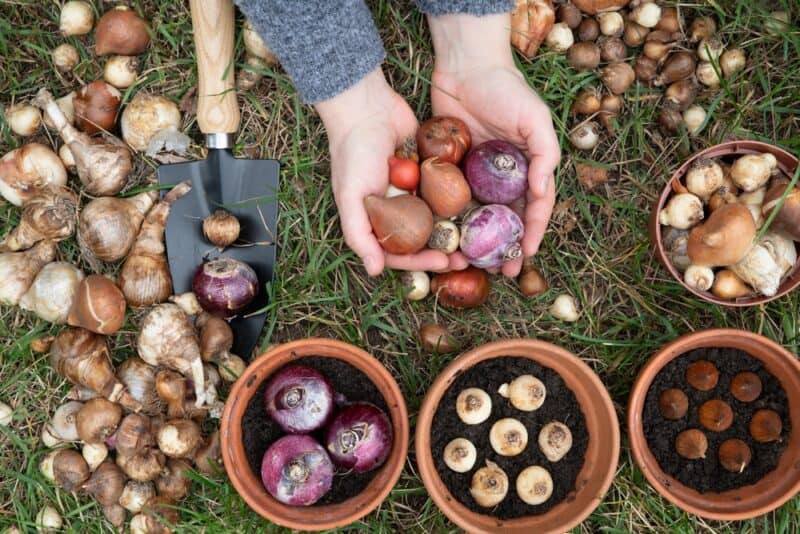
Plant in the ground in the fall for spring flowering. Wait until after the first fall frost, but before the ground is too hard to work.
If you’re growing hyacinths in pots, you can plant from fall to mid-winter if they can be kept in a cold frame or a cool, covered location.
The bulbs need cold stratification before planting or forcing them to grow and bloom. This happens naturally in Zones 7 and below. But if you don’t live in an area with cold winters or it’s out of the winter season, you can keep bulbs in the fridge to stratify them.
This simulates the cold of winter. Once it begins to get warmer, it stimulates growth.
Bulbs need to be planted at least 4-6 inches deep in the soil.
Growing from Seed
Most Dutch hyacinths are hybrids, and any seed produced by the plant and sown may not have the parent plant’s characteristics. That means you never know what you’re going to get.
If you want to guarantee the colors and shapes of the hyacinths you’re planting, then go with bulbs. Otherwise, it’s fun to experiment to see what you get when growing hyacinths from seed.
Forcing
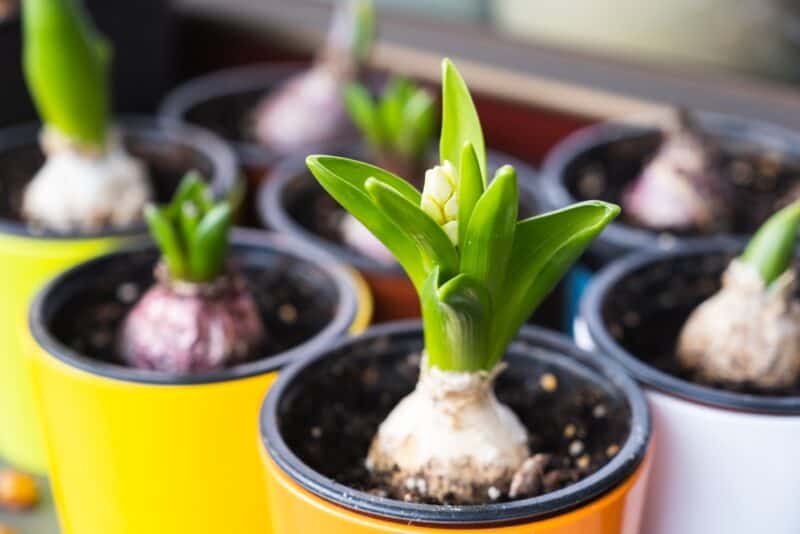
If you plan on forcing your bulbs, which is the practice of growing them out of their natural season, then monitor moisture levels and keep them out of direct sunlight.
If growing hydroponically, do not submerge the bulb in water, but allow the water to touch the base of the bulb. Submerging will encourage rot. In about two weeks, roots will start to develop. This is a fun project for kids and makes for a beautiful display.
Care
Dutch hyacinths are low maintenance and not fussy bulbing plants. They need free draining soil in full sun or part shade, with six to eight hours of sunlight a day. Don’t try growing hyacinths in shade.
Dutch hyacinths have average moisture requirements. Keep an eye on drooping foliage or stunted blooms, which can indicate underwatering. Avoid watering too much; there’s a balance to set. The soil should be barely moist and the surface allowed to dry out.
Plant bulbs in groups of more than five for the largest impact. Just don’t crowd them or they may struggle to grow. An exception is if you grow them temporarily in gift pots or glass vases. Then, a little short-term crowding will be acceptable.
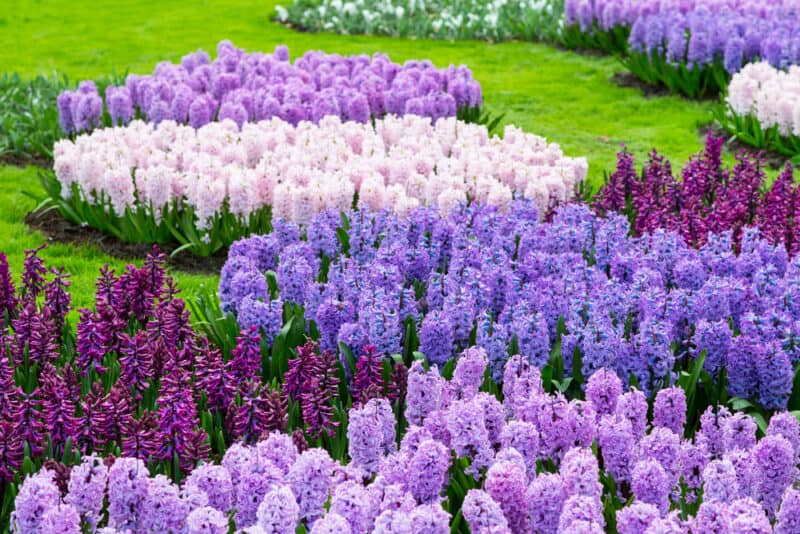
The taller types can grow top-heavy and require staking, especially in windy areas. Staking is also helpful when the plants are in full bloom and it rains heavily.
Trim off spent blooms to encourage regrowth the following spring. Hyacinths have been known to bloom well the first year and then slow down in subsequent years, so deadheading is essential.
Avoid removing foliage until it has wilted and started turning yellow, about ten weeks after the bloom is done. Bulbs will need the die-back process to be completed to absorb as much nutrients as possible for growing new plants next time.
Bulblets are produced by the bulbs through the season. If you want to spread out the show for next year, dig up and separate the bulbs when they’re done blooming. Store the bulbs in a fridge or cool basement, particularly if your summers are hot, until fall, when they can be replanted in groups.
Hyacinths are comfortable in moderately fertile ground. You can succeed at growing hyacinths in anything from sandy loam to loamy clay.
Pests and Diseases
When growing hyacinths, watch out for late spring frosts, as this can cause blackening spots on foliage.
Hyacinths aren’t known to have too many disease issues. However, they may not thrive if conditions aren’t favorable, making them vulnerable to pests and disease.
Hyacinths can contract bulb diseases such as Botrytis blight, caused by fungi in the Botrytis genus.
If the plant fails to bloom or the florets are malformed or abort early, bacterial infections from soft rot or Pectobacterium carotovorum may be the cause.
Deer, chipmunks, squirrels, and rabbits avoid hyacinths as they are toxic and won’t make a nice meal. In fact, Dutch hyacinths have the highest concentration of lycorine and oxalic acid of similar bulbs like tulips and daffodils.
Consumption by pets, livestock, and humans is highly discouraged. Remember, it’s toxic. When handling hyacinths, wear gloves, as they can cause skin irritation in sensitive individuals.
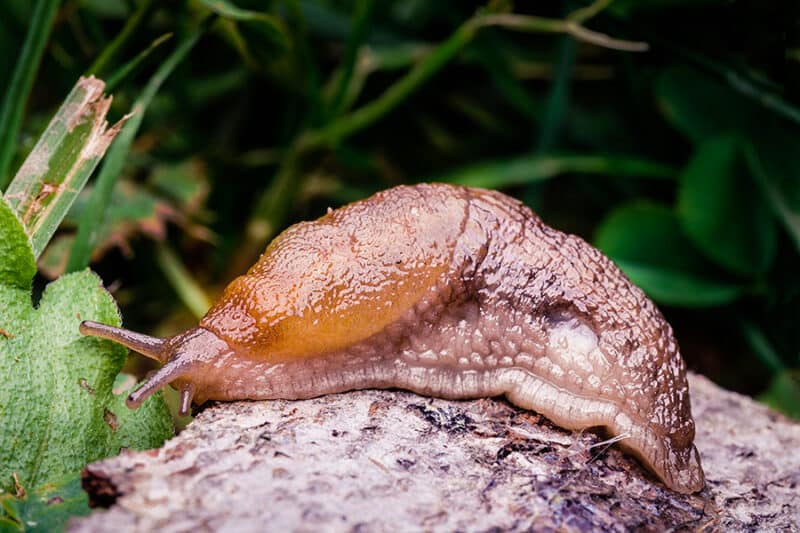
Slugs and snails get drawn to the juiciness of the foliage and dainty florets. Even being toxic, it’s not enough to deter the slimy ones. So keep an eye out and lay traps or bait out if an issue arises.
